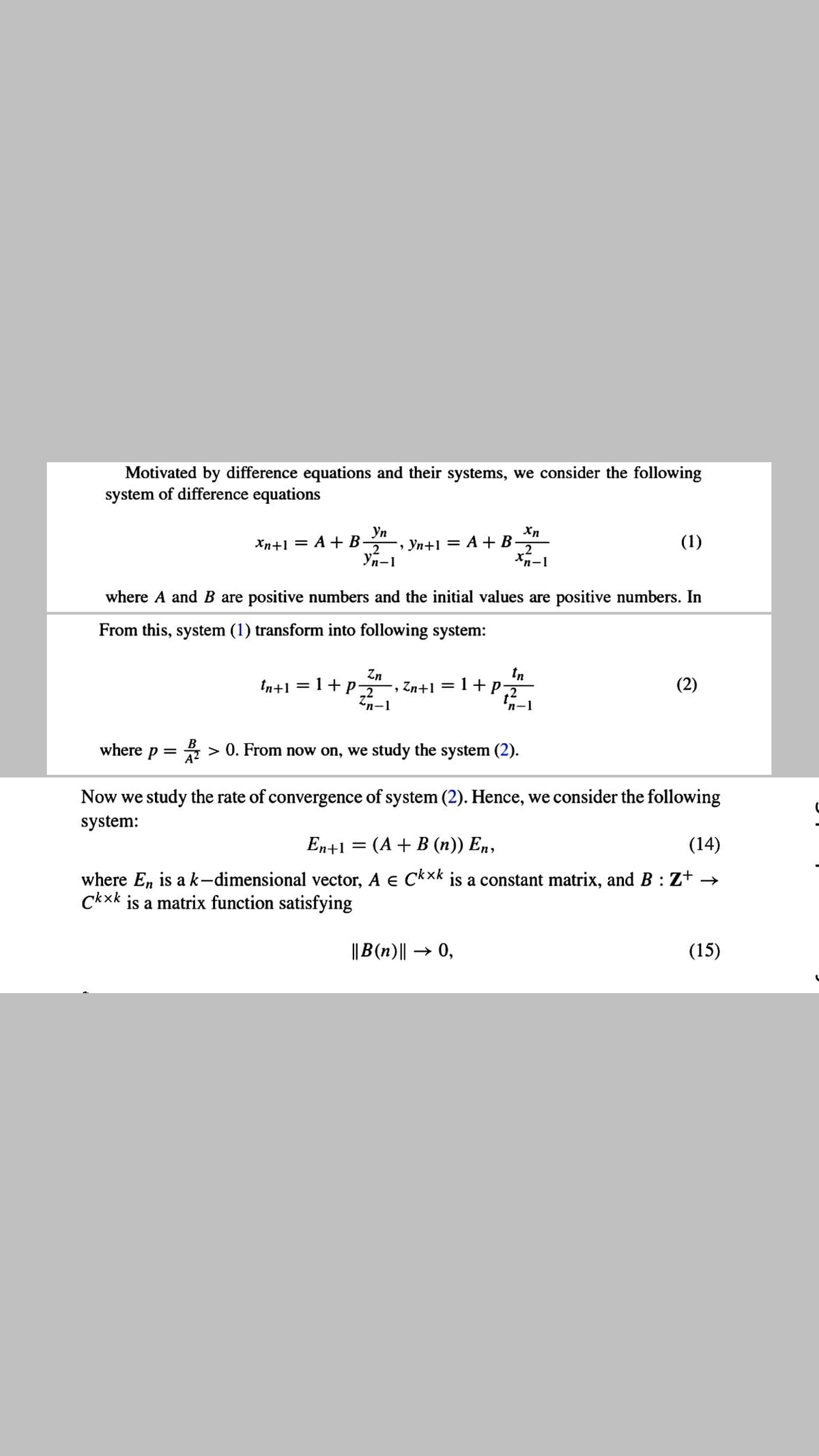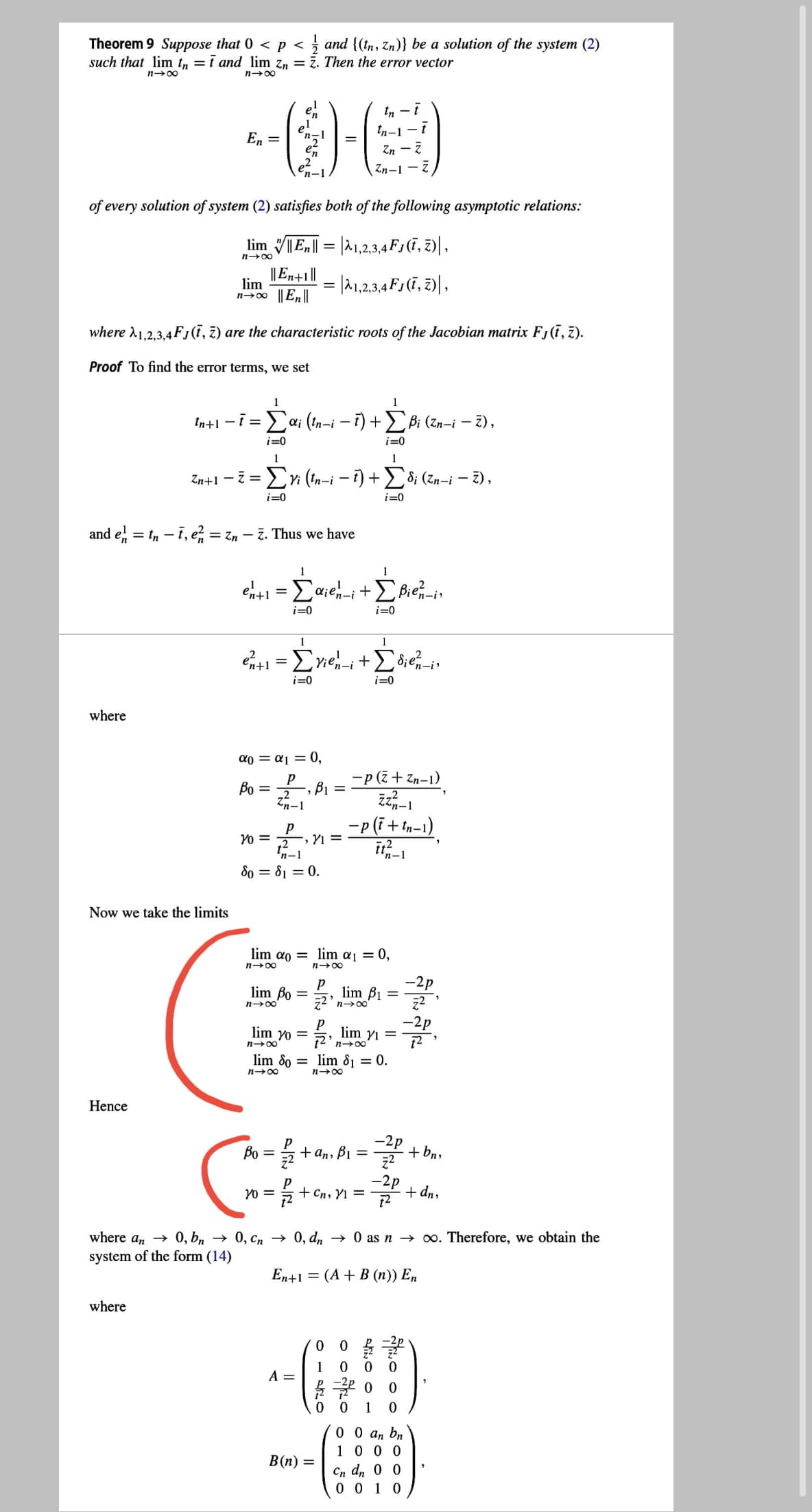where En is a k-dimensional vector, A e Ckxk is a constant matrix, and B : Z+ Ckxk is a matrix function satisfying ||B(n)|| → 0, (15)
where En is a k-dimensional vector, A e Ckxk is a constant matrix, and B : Z+ Ckxk is a matrix function satisfying ||B(n)|| → 0, (15)
Linear Algebra: A Modern Introduction
4th Edition
ISBN:9781285463247
Author:David Poole
Publisher:David Poole
Chapter3: Matrices
Section3.2: Matrix Algebra
Problem 21EQ: Prove the half of Theorem 3.3 (e) that was not proved in the text.
Related questions
Question
Show me the steps of deremine red and inf is here i need evey I need all the details step by step and inf is her

Transcribed Image Text:Motivated by difference equations and their systems, we consider the following
system of difference equations
Xn
Уп
, Yn+1 = A + B-
Уп-1
Xn+1 = A + B-
(1)
Xn-1
where A and B are positive numbers and the initial values are positive numbers. In
From this, system (1) transform into following system:
Zn
, Zn+1 = 1 +p,
n-1
tn+1 = 1+P7
(2)
%3D
n-1
where p = > 0. From now on, we study the system (2).
Now we study the rate of convergence of system (2). Hence, we consider the following
system:
En+1 = (A + B (n)) En,
(14)
where En is a k-dimensional vector, A e Ckxk is a constant matrix, and B : Z+ →
Ckxk is a matrix function satisfying
||B(n)|| → 0,
(15)

Transcribed Image Text:Theorem 9 Suppose that 0 <p <
such that lim tn =i and lim z, = 7. Then the error vector
5 and {(tn, Zn)} be a solution of the system (2)
n-00
n-00
tn - i
tn-1 - i
Zn - Z
en
En =
n-1
en
n-1
Zn-1 – 2
of every solution of system (2) satisfies both of the following asymptotic relations:
lim VE,| = |à1,2,3,4F1 (7, 7)|,
n-00
||En+1||
lim
= |à1,2,3,4 F1(T, 2)|,
n→00 || En||
where A1,2,3,4FJ (7, 7) are the characteristic roots of the Jacobian matrix Fj(i, 7).
Proof To find the error terms, we set
1
1
In+l -i =a; (tn-i – i) +Bi (Zn-i – 7) ,
i=0
i=0
1
1
Zn+1 – ē =
Eri (tn-i - i) + ôi (zn-i – 2),
i=0
i=0
and e = t, – i, e? = zn – 7. Thus we have
1
1
%3D
i=0
i=0
1
n-i
i=0
i=0
where
a0 = a1 = 0,
-p (7 + Zn-1)
Bo =
B1
%3D
Zn-1
-p(i + fn-1).
Yo =
, Yi =
12
'n-1
8o = 81 = 0.
Now we take the limits
lim ao = lim aj = 0,
n-00
n-00
lim Bo =
n-00
-2p
lim B1 =
n00
-2p
lim yo =
n-00
lim
Yi =
12'n-00
lim 8o = lim 81 = 0.
n-00
n-00
Hence
-2p
Bo = + an, Pi =
+ bn,
-2p
+ Cn, Y1 =
+ dn,
YO =
where a, → 0, b, → 0, cn → 0, d, → 0 as n → 00. Therefore, we obtain the
system of the form (14)
En+1
= (A + B (n)) En
where
1
A =
1
0 0 an bn
100 0
B(n) =
Cn dn 0 0
0 0 1 0
io o o
Expert Solution
This question has been solved!
Explore an expertly crafted, step-by-step solution for a thorough understanding of key concepts.
Step by step
Solved in 3 steps

Recommended textbooks for you

Linear Algebra: A Modern Introduction
Algebra
ISBN:
9781285463247
Author:
David Poole
Publisher:
Cengage Learning

Elementary Geometry For College Students, 7e
Geometry
ISBN:
9781337614085
Author:
Alexander, Daniel C.; Koeberlein, Geralyn M.
Publisher:
Cengage,

Algebra & Trigonometry with Analytic Geometry
Algebra
ISBN:
9781133382119
Author:
Swokowski
Publisher:
Cengage

Linear Algebra: A Modern Introduction
Algebra
ISBN:
9781285463247
Author:
David Poole
Publisher:
Cengage Learning

Elementary Geometry For College Students, 7e
Geometry
ISBN:
9781337614085
Author:
Alexander, Daniel C.; Koeberlein, Geralyn M.
Publisher:
Cengage,

Algebra & Trigonometry with Analytic Geometry
Algebra
ISBN:
9781133382119
Author:
Swokowski
Publisher:
Cengage


Elements Of Modern Algebra
Algebra
ISBN:
9781285463230
Author:
Gilbert, Linda, Jimmie
Publisher:
Cengage Learning,